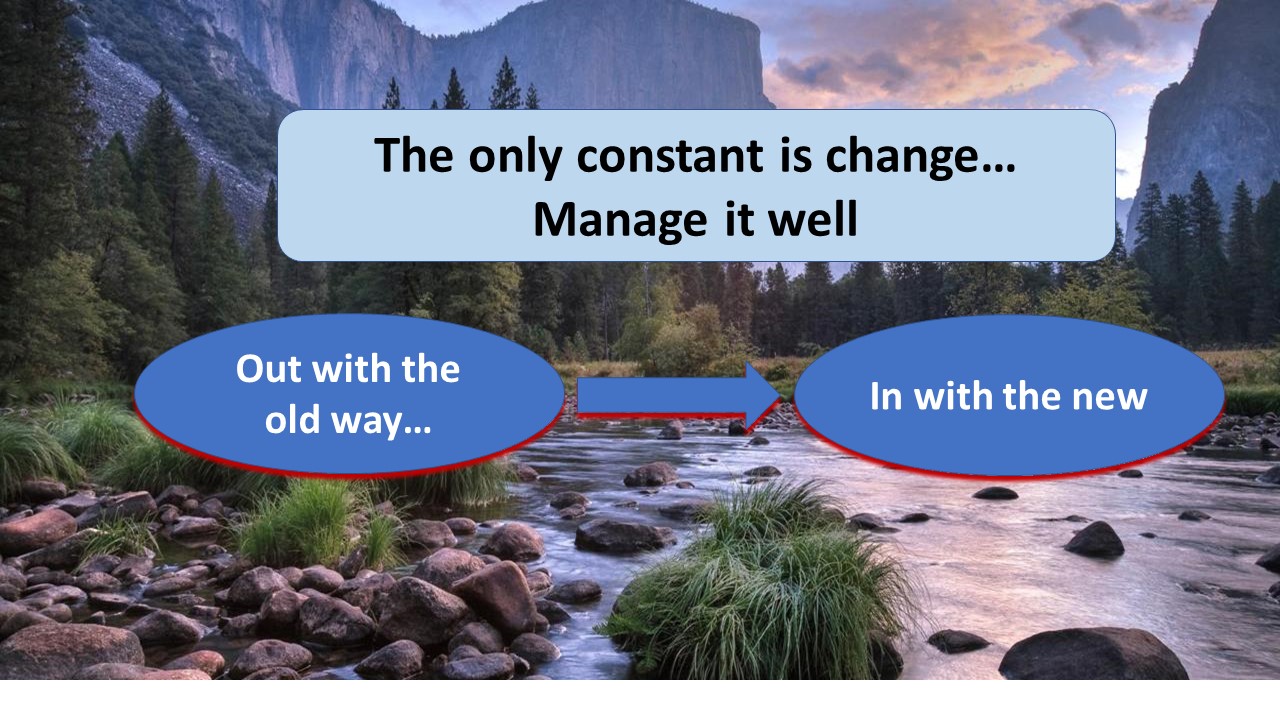By Thomas Davis, CRNA, MAE, DNAP candidate
Follow @procrnatom on twitter
“Somebody ought to…” “If they were smart, they would…” Workers frequently discuss the management flaws during small talk in the lounge and call on those in charge to fix the system; however, it is common for the very people who criticize and call for change to adamantly resist any disruption of business as usual. Whether it arises from the front office or from a grassroots movement, and regardless of the merit of a new plan, variation of routine can be intimidating and evoke both active and passive resistance from the same people who are essential for putting a new strategy into action. Successfully guiding a team through a revision process is a multi-faceted task requiring a leader to unite the workers; a demand that will challenge the skills of even the most experienced boss.
“The world hates change, yet it is the only thing that has brought progress.”
~Charles Kettering
Writing in The Balance Careers, Susan Heathfield connects effective leadership with managing change by emphasizing the importance of the leader’s commitment to implementing the new policy. She suggests 5 essential elements for the leader to put in place if modification is to occur smoothly:
- Have a vision
- Communicate the vision
- Be involved in planning
- Provide structure to support the change
- Designate an executive champion
At the core of implementing change is effective communication of both the proposed plan and the reasons that drive the need for adjusting current procedures. Author Steve Weber (Speakinggump.com) affirms that most people will accept workflow alteration if they understand the vision, are allowed to participate in development, and feel ownership during implementation. According to Weber, transparent disclosure of the plan and its necessity will have the following effects:
- Defective systems will adjust
- Redundant systems will be eliminated
- Major flaws will be exposed and eliminated
- Minor flaws will be tweaked
Leadership is essential for change implementation and management (CIM) regardless of its scope. In a recent conversation with a patient, Joe, an executive level consultant for managing change at USAA insurance provided additional insight about the importance of leadership by sharing actual stories from his work. According to Joe, meaningful and lasting change is difficult to impossible without Active Invisible Management (AIM) Like a duck that appears to be peacefully floating on top of the water and whose legs are churning below the surface, effective leaders display calm confidence in public while churning out some hard work behind the scenes to push the project forward. When I asked Pete about obstacles to anticipate when asking workers to set a new course, he noted two things that can derail implementation.
- The first signs of success Most of us assume that signs of success are a good thing, but Pete noted that top leaders are busy people and as soon as it appears that success is on the horizon, attention gets diverted to other areas and the project loses its AIM. Having a designated executive champion who actively works until the new way becomes part of the team culture is essential, particularly when things appear to be going well.
- Recognition and reward achieved under the old system High achievers who were rewarded under the old system have a vested interest in maintaining the status quo. Leadership must be sensitive and ensure that the most productive people under the old system can also anticipate gaining recognition and reward with the new system.
Even after clearly communicating the proposed plan and its necessity, you may still need to address a question from your team; “what’s in it for me?” Answer the question in a confident manner with a focus on benefits for both the individual and the organization with emphasis on the following:
- Achieving personal / professional growth
- Developing adaptive flexibility
- Challenging old beliefs and accepting alternative methods
- Showcasing strengths
- Mastering the stress associated with the unknown
- Breaking ho-hum routine
- Opening the opportunity to create a fresh future
“Change has a bad reputation in our society. But it isn’t all bad – not by any means. In fact, change is necessary in life – to keep us moving, to keep us growing, to keep us interested. Imagine life without change. It will be static, boring, dull.”
–~Dr. Dennis O’Grady
Successfully guiding a team through the process of change is a multi-faceted process that can cause trepidation from even the most experienced leader. Rather than cowering in fear of the lunchroom nay-sayers, clearly communicate the new plan and engage high-achievers from the old system to assume a prominent position in the new scheme. Confidently position yourself and your team to be the trailblazers within the organization and be the first to reap the rewards that accompany successful implementation of change.
Tom is a noted author, enthusiastic speaker, committed leadership developer and superb clinical anesthetist. Contact tom@prosynex.com to book a speaking engagement.





